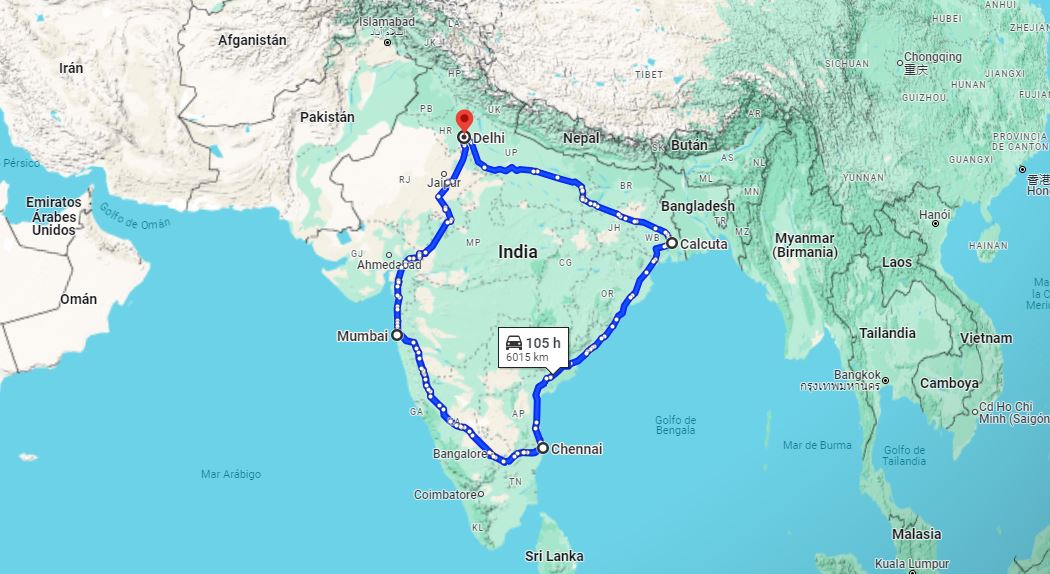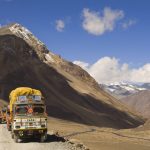The Golden Quadrilateral (GQ) is a network of highways connecting the four major metropolitan cities of India: Delhi, Mumbai, Chennai, and Kolkata. It is the longest road network in India, with a total length of 5,846 km (3,633 mi).
| Country | India |
| Length | 5,846 km (3,633 mi) |
| Main cities | Delhi, Kolkata, Chennai, Mumbai |
The primary objective of the Golden Quadrilateral project was to improve road connectivity between the major cities of India and to boost economic development by facilitating the efficient movement of goods and people. It forms a quadrilateral shape on the map, hence the name.

The Golden Quadrilateral comprises a network of four-lane highways that connect the following four major metropolitan cities in India, forming a quadrilateral shape.
- The Delhi-Mumbai section: This section is the longest section of the GQ, with a length of 1,453 kilometers (903 miles). It passes through the states of Haryana, Uttar Pradesh, Madhya Pradesh, and Gujarat.
- The Mumbai-Chennai section: This section is the second longest section of the GQ, with a length of 1,290 kilometers (803 miles). It passes through the states of Maharashtra, Andhra Pradesh, and Tamil Nadu.
- The Chennai-Kolkata section: This section is the third longest section of the GQ, with a length of 1,074 kilometers (667 miles). It passes through the states of Andhra Pradesh, Telangana, Orissa, and West Bengal.
- Chennai-Kolkata section: This section is the shortest section of the GQ, with a length of 729 kilometers (453 miles). It passes through the states of Uttar Pradesh, Bihar, and Jharkhand.
The project was implemented in multiple phases. The construction was planned in 1999, launched in 2001, and was completed in 7 January 2012. It aimed to upgrade existing highways and construct new ones to connect the designated cities.
Aspects to consider when driving on the Golden Quadrilateral
- Road Quality: The Golden Quadrilateral is known for its well-maintained highways. The roads are generally smooth and in good condition, allowing for a comfortable and efficient drive. However, it’s essential to be cautious of occasional potholes, especially during the monsoon season.
- Traffic Conditions: Traffic conditions can vary along different stretches of the Golden Quadrilateral. While some parts may have heavy traffic, particularly near urban centers, other sections may offer a smoother and more relaxed driving experience. It’s advisable to plan your journey, considering the time of day and potential traffic hotspots.
- Scenery and Landscapes: The GQ passes through diverse landscapes, ranging from urban areas to rural countryside. You’ll encounter varying scenery, including farmlands, small towns, and cultural landmarks. The journey provides a glimpse into the rich tapestry of India’s geography and culture.
- Pit Stops and Amenities: There are numerous rest areas, fuel stations, and eateries along the Golden Quadrilateral, making it convenient for travelers to take breaks, refuel, and enjoy local cuisine. It’s a good idea to plan your pit stops in advance, ensuring that you have access to essential amenities.
- Weather Considerations: India has diverse climatic conditions, and the weather can vary depending on the region and time of year. It’s important to check the weather forecast and be prepared for any adverse conditions, such as heavy rain, especially during the monsoon season.
- Cultural Experiences: The Golden Quadrilateral traverses regions with distinct cultural identities. Consider exploring local attractions, historical sites, and experiencing the unique customs and traditions of the areas you pass through.
- Safety Precautions: Always adhere to traffic rules, wear seat belts, and drive responsibly. It’s advisable to have a well-maintained vehicle, carry necessary documents, and be aware of emergency services along the route.
A road trip along the Golden Quadrilateral offers an opportunity to witness the diversity of India, both in terms of landscapes and cultures. With proper planning and precautions, it can be a memorable and enjoyable journey.
Key Cities Connected
- Delhi (North): The national capital and a major political and economic center.
- Mumbai (West): The financial capital of India and a major port city.
- Chennai (South): A major industrial and cultural hub in South India.
- Kolkata (East): A historic city and important economic center in East India.
Economic Impact
The Golden Quadrilateral has had a significant impact on the economic development of the regions it connects. It has facilitated smoother transportation of goods, reduced travel time, and improved overall connectivity. One of the primary benefits of the Golden Quadrilateral is the reduction in travel time between the major cities. The improved road infrastructure allows for faster and more efficient transportation. The project has transformed the regions around the quadrilateral into a major commercial corridor, fostering trade and industrial development. The project has led to significant infrastructure development, including the construction of overpasses, flyovers, and modern toll plazas.
Golden Quadrilateral Map
This is the 5,846 km (3,633 mi) Golden Quadrilateral Map, see it in Google Maps.

The Golden Quadrilateral Road Map













